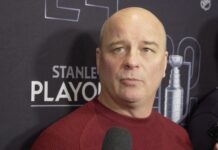 Last week I had the privilege of speaking with Rick Dudley, Director of Player Personnel for the Toronto Maple Leafs, for a feature in the forthcoming Maple Leafs Annual magazine. We had asked for a few of your questions for Mr. Dudley, and were able to work some of them in during the course of the interview.
Last week I had the privilege of speaking with Rick Dudley, Director of Player Personnel for the Toronto Maple Leafs, for a feature in the forthcoming Maple Leafs Annual magazine. We had asked for a few of your questions for Mr. Dudley, and were able to work some of them in during the course of the interview.
Follow the jump for excerpts featuring your questions. As with Alex’s prior interview with Dave Morrison, please bear in mind that the flow of questions may seem a little off as these are excerpts pulled from various sections.
The full interview will appear in the Maple Leafs Annual this September.
GB: We often hear players comment on having to adjust to the level of attention and scrutiny that comes with a market such as Toronto. Does the same hold true for management also?
RD: Certainly there’s a little more scrutiny in a city like Toronto, more media coverage. Fortunately for me, I’m a little ways down the totem pole so I’m not as subject to it. That’s really Brian [Burke]’s baby. But it is a different market, obviously the fans are incredibly passionate. Even the Director of Player Personnel will be relatively well known in Toronto. It’s a fact of life, and you have to get used to that. I was fortunate enough to have been the General Manager of the Ottawa Senators so I have a bit of experience with Canadian hockey markets and staunch, steadfast hockey fans.
GB: What are your thoughts on a rather unique free agency period, with a number of teams needing to reach the cap floor and the contracts we saw on July 1st as a result?
RD: I’m glad we didn’t get overly involved. There were dollars that were spent in very high amounts, but maybe more significant was the term involved in some of those contracts. We did sign Tim Connolly, who is a very talented guy, to a two year deal. I think that allows for some flexibility, and there is a little more pressure on the athlete to perform in a short term deal.
GB: What sort of advantages does a shorter-term deal such as Connolly’s create?
RD: I think there’s going to be some opportunities moving forward. What some teams never count on is that some of their prospects are going to become National Hockey League players in a hurry. It’s inevitable and it will happen. There will be teams that signed players to meet cap requirements and get their rosters filled out, and some of the kids they drafted this year or the year before will make their team. And at that point in time they will not be able to trade that guy they just signed to a long-term, high-dollar deal. They will instead be forced to trade something that is an asset in order to create the necessary roster space for the kids. And if you have put your team in the right position, you can acquire one of those assets.
GB: There’s been a fair amount of talk about offer sheets, and the seemingly league-wide lack of interest in pursuing that option. Can you comment on why teams are hesitant or reluctant to sign restricted free agents to offer sheets?
RD: There are a number of reasons, draft pick compensation value among them, but the bottom line is you have to take into consideration whether or not the team would match your offer. If you think they would match, there’s no point in doing it. That’s Brian’s call, and I would suppose Brian hasn’t seen a restricted free agent he likes that he doesn’t believe would be matched.
GB: When it comes to evaluating players, there are obviously a number of statistical or measurable characteristics that come into play. What are some of the non-measurable characteristics that you look at to differentiate players whose measurables may be similar?
RD: Wow, where do I start? In today’s game, there are two things that are essential: hockey sense and character. If a player lacks a high score in either of those components he is far less likely to be effective. You have to be phenomenally talented to succeed without hockey sense and/or character.
After that, skating ability in today’s game is very important, especially for defensemen who need to get back to retrieve a puck. Skill components are very important, things such as vision and what we call soft hands. Physique or body type is also a factor. Going back to hockey sense, you have to know what a player tends to do with and without the puck, what they do in coverage. There are so many different components. Over the years I have tried to put together in my mind what the perfect hockey player would be. But you know, there are some players who can have all of those components – hockey sense, character, skating ability, skill, physique – and then you have to find reasons why he may not make it. And if a player has the skill components, physique and skating ability, it is then only those first two components – hockey sense and character – that will keep him out.
What I would do when I talked to scouts who worked for me in the past was tell them to break down those three components [skill, physique, skating] first. If the players have the three components, then you start to look at their hockey sense and character, and really start to zero in on those because they are so vital.
GB: Looking at the Maple Leafs‘ past season, we see a team that endured a terrible November and December before coming on strong in the second half and falling just short of the playoffs. Looking a bit further back, we a see a team that two years ago also struggled out of the gate before turning a strong second half. When you have such a young team, what is the key to avoiding those kinds of an extended slumps in a league where one bad month can effectively do a team in?
RD: One of the keys is having a good training camp, and having players come to training camp in as good of shape as humanly possible. And that’s not easy, sometimes you have to show them how to do it. Teams need to have twelve-month plans for all of their players, customized to the needs of each individual to ensure they are able to play at their optimal level. In Atlanta last year, some of our players regressed a bit following a terrific start, and it cost us a playoff spot. And perhaps that was our fault on a management level for not having the right plan to see our guys through an entire season.
GB: Can you see similarities between the Maple Leafs and the team you had in Atlanta, or the team you had in Chicago when you were there?
RD: There are phases in the evolution of a hockey team. I think we are further along than Atlanta was when I arrived there, and certainly way further along than Chicago was when Dale Tallon became the GM and I became his assistant. We were not a very good hockey team, and we did a complete facelift. On the team that won the Stanley Cup [five years later], there wasn’t a single player left from before Dale took over.
Here in Toronto, a lot of work has already been done. We no longer have to take a blanket approach. We’re at the point where we have the luxury of focusing on specific areas which need improvement. So that puts us ahead, in many respects, of where things stood when I arrived in Atlanta, and when I arrived in Chicago.
GB: Can you comment on the return of the NHL to Winnipeg, and what the fans can expect of their team?
RD: It’s a great hockey city, I played there and I enjoyed it immensely. The fans were very good to me and I know they will undoubtedly support their team and its players. I don’t think they have any idea how good of a team they have. There’s a lot of talent on that team. We went through a stretch of twenty-one games where we won only four, and that knocked us out of a playoff spot. Other than that stretch, we were a very good team, and over the first half of the season were one of the top teams in the league. All their players have to do right now is focus on learning how to avoid making mistakes, which is true of any young group. They have the potential to be an excellent team for a very long time.


![Sheldon Keefe on the Maple Leafs’ struggling power play: “[We’ve scored] one out of 11 high-danger chances in tight to the net… We have been in those spots and haven’t converted” Sheldon Keefe, playoff press conference](https://mapleleafshotstove.com/wp-content/uploads/2024/04/keefe-pc-game-3-218x150.jpg)

![Jim Montgomery Post Game, Bruins 4 vs. Leafs 2: “[Marchand] still manages to get under people’s skin, yet he doesn’t cross the line” Jim Montgomery, Boston Bruins post game](https://mapleleafshotstove.com/wp-content/uploads/2024/04/jim-monty-pg-to-218x150.jpg)
























![Sheldon Keefe on the Maple Leafs’ struggling power play: “[We’ve scored] one out of 11 high-danger chances in tight to the net… We have been in those spots and haven’t converted” Sheldon Keefe, playoff press conference](https://mapleleafshotstove.com/wp-content/uploads/2024/04/keefe-pc-game-3-100x70.jpg)



![Jim Montgomery Post Game, Bruins 4 vs. Leafs 2: “[Marchand] still manages to get under people’s skin, yet he doesn’t cross the line” Jim Montgomery, Boston Bruins post game](https://mapleleafshotstove.com/wp-content/uploads/2024/04/jim-monty-pg-to-100x70.jpg)


